Climate Driver Influences on Prediction of the Australian Fire Behaviour Index
Abstract
:1. Introduction
2. Materials and Methods
- Grassland fuel loads: Characterised based on Köppen climate zones, these were assumed to be constant throughout the climatology.
- Time-since-fire: Employed for all fuel types except pine, grassland, and grassy woodland, these data extend back to 2003 (Gregory, P., personal communication).
- Generic fuel state: Inputs relied on established models from relevant literature with tailored adjustments and assumptions in some instances.
- Jurisdictional fuel datasets: These, along with associated research documents, informed decisions regarding overstorey subtypes and coverage values (Matthews, 2023, personal communication).
3. Results and Discussion
3.1. Prediction of Extreme Fire Behaviour Index
3.2. Prediction Associated with ENSO
3.3. Prediction Associated with the SAM
3.4. Prediction Associated with the IOD
3.5. Prediction Associated with the STRH
3.6. Prediction Associated with Split-Flow Blocking
3.7. Prediction Associated with the Madden-Julian Oscillation
4. Synthesis
5. Concluding Remarks
Author Contributions
Funding
Institutional Review Board Statement
Informed Consent Statement
Data Availability Statement
Acknowledgments
Conflicts of Interest
References
- Clarke, H.; Lucas, C.; Smith, P. Changes in Australian fire weather between 1973 and 2010. Int. J. Climatol. 2013, 33, 931–944. [Google Scholar] [CrossRef]
- Dowdy, A.J. Climatological Variability of Fire Weather in Australia. J. Appl. Meteorol. Climatol. 2018, 57, 221–234. [Google Scholar] [CrossRef]
- Commonwealth of Australia. A Nation Charred: Report on the Inquiry into Bushfires; Nairn, G., Ed.; Commonwealth of Australia: Canberra, Australia, 2003.
- Teague, B.; Pascoe, S.; McLeod, R. The 2009 Victorian Bushfires Royal Commission Final Report: Summary; Parliament of Victoria: Melbourne, Australia, 2010.
- Filkov, A.I.; Ngo, T.; Matthews, S.; Telfer, S.; Penman, T.D. Impact of Australia’s catastrophic 2019/20 bushfire season on communities and environment. Retrospective analysis and current trends. J. Saf. Sci. Resil. 2020, 1, 44–56. [Google Scholar] [CrossRef]
- Moreira, F.; Ascoli, D.; Safford, H.; Adams, M.A.; Moreno, J.M.; Pereira, J.M.; Catry, F.X.; Armesto, J.; Bond, W.; González, M.E.; et al. Wildfire management in Mediterranean-type regions: Paradigm change needed. Environ. Res. Lett. 2020, 15, 011001. [Google Scholar] [CrossRef]
- Moritz, M.A.; Batllori, E.; Bradstock, R.A.; Gill, A.M.; Handmer, J.; Hessburg, P.F.; Leonard, J.; McCaffrey, S.; Odion, D.C.; Schoennagel, T.; et al. Learning to coexist with wildfire. Nature 2014, 515, 58–66. [Google Scholar] [CrossRef]
- Nolan, R.H.; Bowman, D.M.; Clarke, H.; Haynes, K.; Ooi, M.K.; Price, O.F.; Williamson, G.J.; Whittaker, J.; Bedward, M.; Boer, M.M. What Do the Australian Black Summer Fires Signify for the Global Fire Crisis? Fire 2021, 4, 97. [Google Scholar] [CrossRef]
- Iwakiri, T.; Imada, Y.; Takaya, Y.; Kataoka, T.; Tatebe, H.; Watanabe, M. Triple-Dip La Niña in 2020–23: North Pacific Atmosphere Drives 2nd Year La Niña. Geophys. Res. Lett. 2023, 50, e2023GL105763. [Google Scholar] [CrossRef]
- O’Donnell, A.J.; Boer, M.M.; McCaw, W.L.; Grierson, P.F. Climatic anomalies drive wildfire occurrence and extent in semi-arid shrublands and woodlands of southwest Australia. Ecosphere 2011, 2, 1–15. [Google Scholar] [CrossRef]
- Letnic, M.; Dickman, C.R. Boom Means Bust: Interactions between the El Niño/Southern Oscillation (ENSO), Rainfall and the Processes Threatening Mammal Species in Arid Australia. Biodivers. Conserv. 2006, 15, 3847–3880. [Google Scholar] [CrossRef]
- Bureau of Meteorology. Climate Outlooks. 31 August 2023. Available online: http://www.bom.gov.au/climate/outlooks/#/overview/summary (accessed on 5 September 2023).
- Bureau of Meteorology. Australian Rainfall during El Niño and La Niña Events. 2023. Available online: http://www.bom.gov.au/climate/history/enso/ (accessed on 14 December 2023).
- Palmer, J.G.; Cook, E.R.; Turney, C.S.; Allen, K.; Fenwick, P.; Cook, B.I.; O’Donnell, A.; Lough, J.; Grierson, P.; Baker, P. Drought variability in the eastern Australia and New Zealand summer drought atlas (ANZDA, CE 1500–2012) modulated by the Interdecadal Pacific Oscillation. Environ. Res. Lett. 2015, 10, 124002. [Google Scholar] [CrossRef]
- Biskin, M.; Bennett, A.; Macintosh, A. Chapter 17: Public and private land management. In Royal Commission into National Natural Disaster Arrangements Report; Commonwealth of Australia: Canberra, Australia, 2020. [Google Scholar]
- Marshall, A.G.; Gregory, P.A.; de Burgh-Day, C.O.; Griffiths, M. Subseasonal drivers of extreme fire weather in Australia and its prediction in ACCESS-S1 during spring and summer. Clim. Dyn. 2021, 58, 523–553. [Google Scholar] [CrossRef]
- McArthur, A.G. Fire Behaviour in Eucalypt Forests; Commonwealth of Australia: Canberra, Australia, 1967.
- Matthews, S. Fire Behaviour Index Technical Guide. 2022. Available online: https://www.afac.com.au/initiative/afdrs/technical-resources (accessed on 3 August 2023).
- Matthews, S.; Fox-Hughes, P.; Grootemaat, S.; Hollis, J.J.; Kenny, B.J.; Sauvage, S. Australian Fire Danger Rating System: Research Prototype; NSW Rural Fire Service: Lidcombe, Australia, 2019.
- Australian Bureau of Meteorology. Bureau of Meteorology Fire Behaviour Model Guides. 2022. Available online: https://www.afac.com.au/initiative/afdrs/article/bom-fire-behaviour-model-guides (accessed on 3 August 2023).
- Fox-Hughes, P.; Benger, N.; Gregory, P. AFAC Conference: Report: Progress towards a new national seasonal fire outlook. Aust. J. Emerg. Manag. 2022, 37, 59–62. [Google Scholar]
- Wedd, R.; Alves, O.; de Burgh-Day, C.; Down, C.; Griffiths, M.; Hendon, H.H.; Hudson, D.; Li, S.; Lim, E.P.; Marshall, A.G.; et al. ACCESS-S2: The upgraded Bureau of Meteorology multi-week to seasonal prediction system. J. South. Hemisph. Earth Syst. Sci. 2022, 72, 218–242. [Google Scholar] [CrossRef]
- Marshall, A.G.; Hudson, D.; Wheeler, M.C.; Alves, O.; Hendon, H.H.; Pook, M.J.; Risbey, J.S. Intra-seasonal drivers of extreme heat over Australia in observations and POAMA-2. Clim. Dyn. 2014, 43, 1915–1937. [Google Scholar] [CrossRef]
- Marshall, A.G.; Wheeler, M.C.; Cowan, T. Madden-Julian Oscillation Impacts on Australian Temperatures and Extremes. J. Clim. 2023, 36, 335–357. [Google Scholar] [CrossRef]
- Pook, M.J.; Risbey, J.S.; McIntosh, P.C.; Ummenhofer, C.C.; Marshall, A.G.; Meyers, G.A. The Seasonal Cycle of Blocking and Associated Physical Mechanisms in the Australian Region and Relationship with Rainfall. Mon. Weather Rev. 2013, 141, 4534–4553. [Google Scholar] [CrossRef]
- Risbey, J.S.; Pook, M.J.; McIntosh, P.C.; Wheeler, M.C.; Hendon, H.H. On the Remote Drivers of Rainfall Variability in Australia. Mon. Weather Rev. 2009, 137, 3233–3253. [Google Scholar] [CrossRef]
- Cowan, T.; Wheeler, M.; Marshall, A.G. The combined influence of the Madden-Julian Oscillation and El Niño Southern Oscillation on Australian rainfall. J. Clim. 2023, 36, 313–334. [Google Scholar] [CrossRef]
- Taylor, R.; Marshall, A.G.; Crimp, S.; Cary, G.J.; Harris, S.; Sauvage, S. Associations between Australian climate drivers and extreme weekly fire danger. Int. J. Wildland Fire 2023, 33, WF23060. [Google Scholar] [CrossRef]
- Kalnay, E.; Kanamitsu, M.; Kistler, R.; Collins, W.; Deaven, D.; Gandin, L.; Iredell, M.; Saha, S.; White, G.; Woollen, J. The NCEP/NCAR 40-year reanalysis project. Bull. Am. Meteorol. Soc. 1996, 77, 437–471. [Google Scholar] [CrossRef]
- Ferro, C.A.; Stephenson, D.B. Extremal dependence indices: Improved verification measures for deterministic forecasts of rare binary events. Weather Forecast. 2011, 26, 699–713. [Google Scholar] [CrossRef]
- Magnusson, L.; Haiden, T.; Richardson, D. Verification of Extreme Weather Events: Discrete Predictands; European Centre for Medium-Range Weather Forecasts: Reading, UK, 2014. [Google Scholar]
- North, R.; Trueman, M.; Mittermaier, M.; Rodwell, M.J. An assessment of the SEEPS and SEDI metrics for the verification of 6 h forecast precipitation accumulations. Meteorol. Appl. 2013, 20, 164–175. [Google Scholar] [CrossRef]
- Collaboration for Australian Weather and Climate Research. Forecast Verification Issues, Methods and FAQ. In Proceedings of the 7th International Verification Methods Workshop, Berlin, Germany, 8–11 May 2017. [Google Scholar]
- Wheeler, M.C.; Hendon, H.H. An All-Season Real-Time Multivariate MJO Index: Development of an Index for Monitoring and Prediction. Mon. Weather Rev. 2004, 132, 1917–1932. [Google Scholar] [CrossRef]
- Trenberth, K.E. The Definition of El Niño. Bull. Am. Meteorol. Soc. 1997, 78, 2771–2778. [Google Scholar] [CrossRef]
- Saji, N.H.; Yamagata, T. Possible impacts of Indian Ocean Dipole mode events on global climate. Clim. Res. 2003, 25, 151–169. [Google Scholar] [CrossRef]
- Gong, D.; Wang, S. Definition of Antarctic oscillation index. Geophys. Res. Lett. 1999, 26, 459–462. [Google Scholar] [CrossRef]
- Pook, M.; Gibson, T. Atmospheric blocking and storm tracks during SOP-1 of the FROST Project. Aust. Meteorol. Mag. 1999, 48, 51–60. [Google Scholar]
- Bureau of Meteorology. Bushfire Weather. 2022. Available online: http://www.bom.gov.au/weather-services/fire-weather-centre/bushfire-weather/index.shtml (accessed on 20 September 2022).
- Dowdy, A.J. Seamless climate change projections and seasonal predictions for bushfires in Australia. J. South. Hemisph. Earth Syst. Sci. 2020, 70, 120–138. [Google Scholar] [CrossRef]
- Clarke, H.; Evans, J.P. Exploring the future change space for fire weather in southeast Australia. Theor. Appl. Climatol. 2018, 136, 513–527. [Google Scholar] [CrossRef]
- Clarke, H.; Pitman, A.J.; Kala, J.; Carouge, C.; Haverd, V.; Evans, J.P. An investigation of future fuel load and fire weather in Australia. Clim. Change 2016, 139, 591–605. [Google Scholar] [CrossRef]
- Fox-Hughes, P. Future fire danger climatology for Tasmania, Australia, using a dynamically downscaled regional climate model. Int. J. Wildland Fire 2014, 23, 309–321. [Google Scholar] [CrossRef]
- Cary, G. Importance of a changing climate for fire regimes in Australia. In Flammable Australia: The Fire Regimes and Biodiversity of a Continent; Cambridge University Press: Cambridge, UK, 2002; pp. 26–46. [Google Scholar]
- Pitman, A.; Narisma, G.; McAneney, J. The impact of climate change on the risk of forest and grassland fires in Australia. Clim. Chang. 2007, 84, 383–401. [Google Scholar] [CrossRef]
- Taylor, R.; Marshall, A.G.; Crimp, S.; Harris, S.; Cary, G.J.; Gregory, P. Observed Associations between Fire Danger and Climate Modes and their Representation in ACCESS-S2. J. Appl. Meteorol. Climatol. 2023. submitted. [Google Scholar]
- Harris, S.; Lucas, C. Understanding the variability of Australian fire weather between 1973 and 2017. PLoS ONE 2019, 14, e0222328. [Google Scholar] [CrossRef] [PubMed]
- Cai, W.; Santoso, A.; Collins, M.; Dewitte, B.; Karamperidou, C.; Kug, J.S.; Lengaigne, M.; McPhaden, M.J.; Stuecker, M.F.; Taschetto, A.S.; et al. Changing El Niño–Southern Oscillation in a warming climate. Nat. Rev. Earth Environ. 2021, 2, 628–644. [Google Scholar] [CrossRef]
- Hendon, H.H.; Thompson, D.W.J.; Wheeler, M.C. Australian Rainfall and Surface Temperature Variations Associated with the Southern Hemisphere Annular Mode. J. Clim. 2007, 20, 2452–2467. [Google Scholar] [CrossRef]
- Marshall, A.G.; Wang, G.M.; Hendon, H.H.; Lin, H. Madden-Julian Oscillation teleconnections to Australian springtime temperature extremes and their prediction in ACCESS-S1. Clim. Dyn. 2023, 61, 431–447. [Google Scholar] [CrossRef]
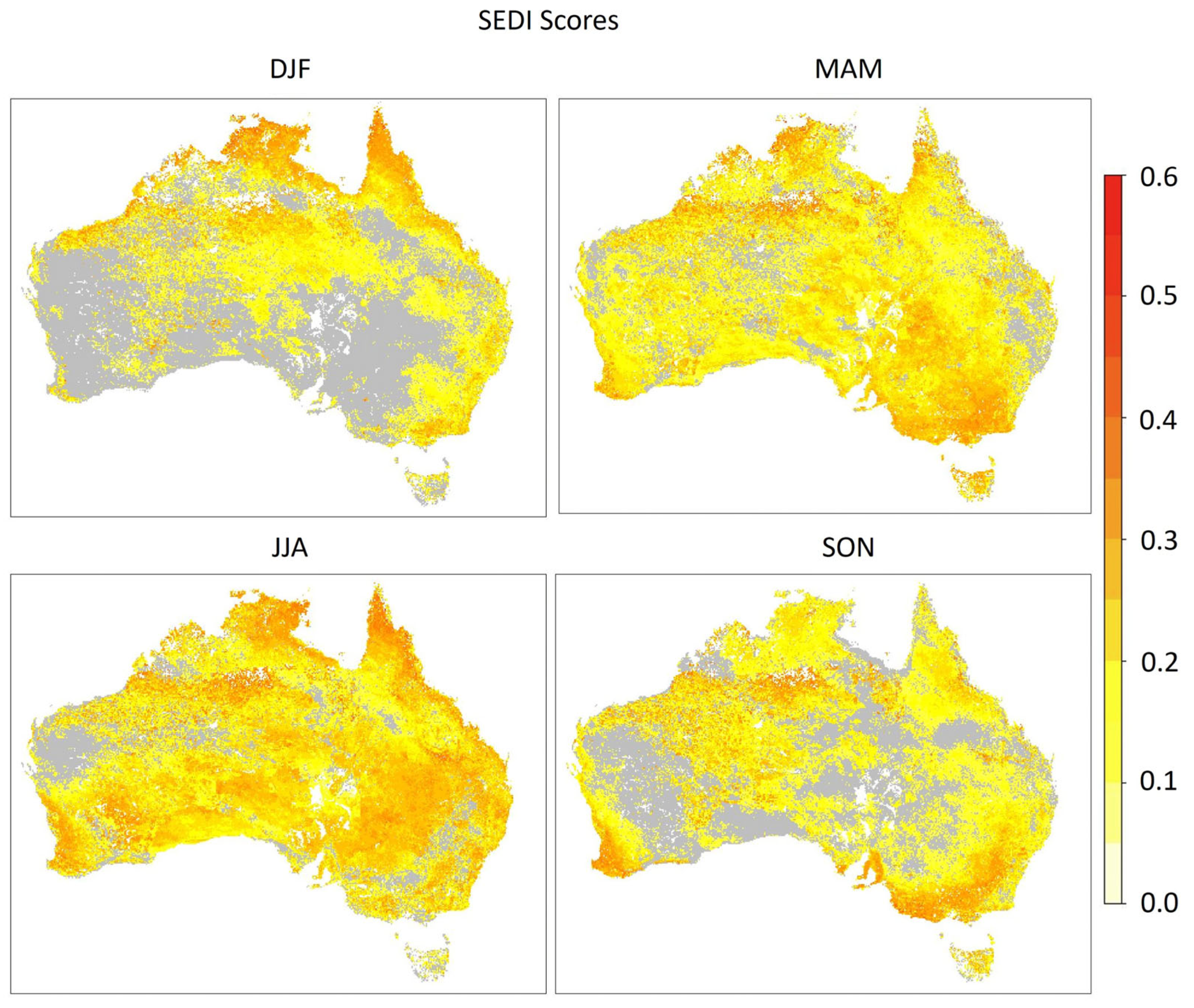

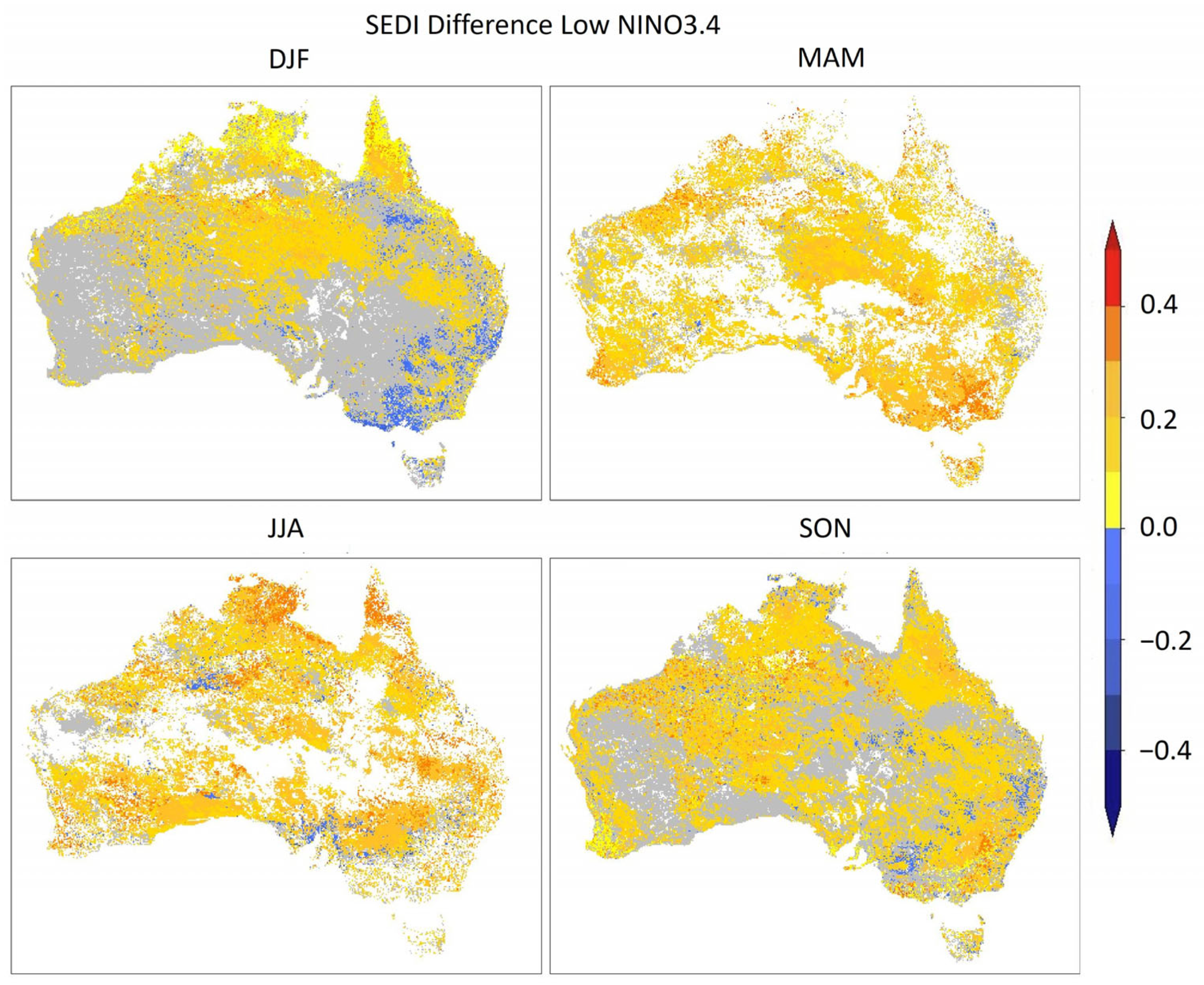
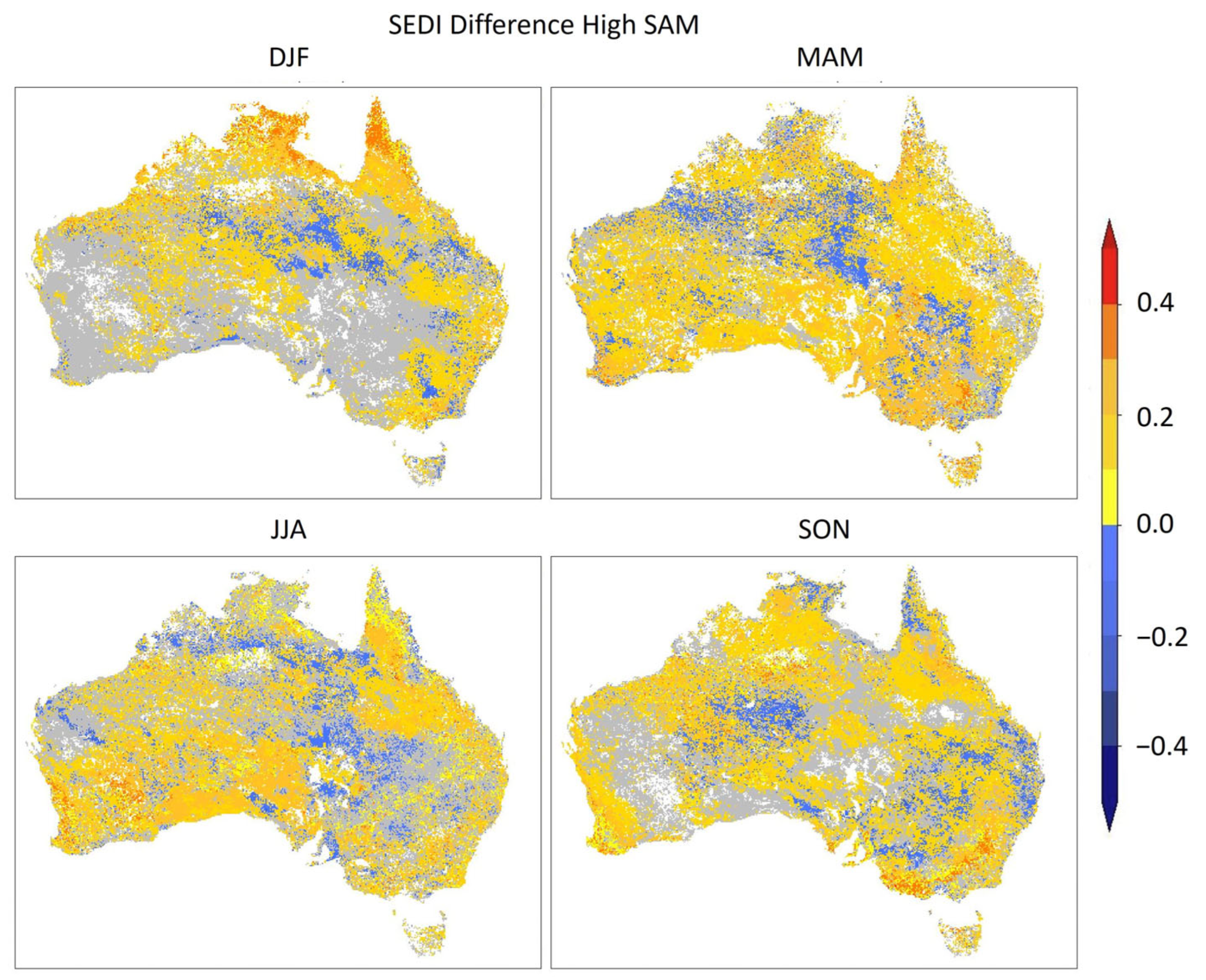




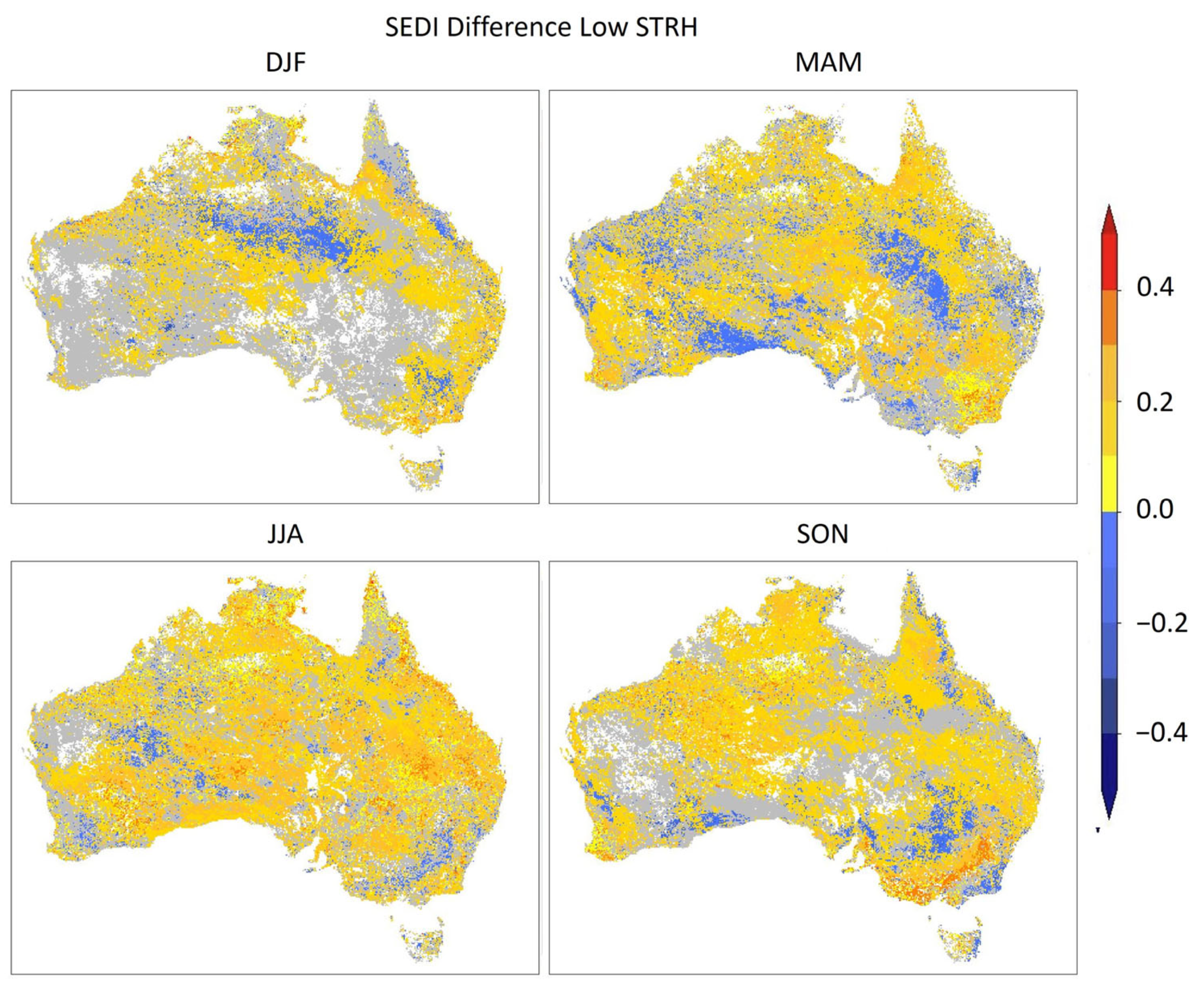
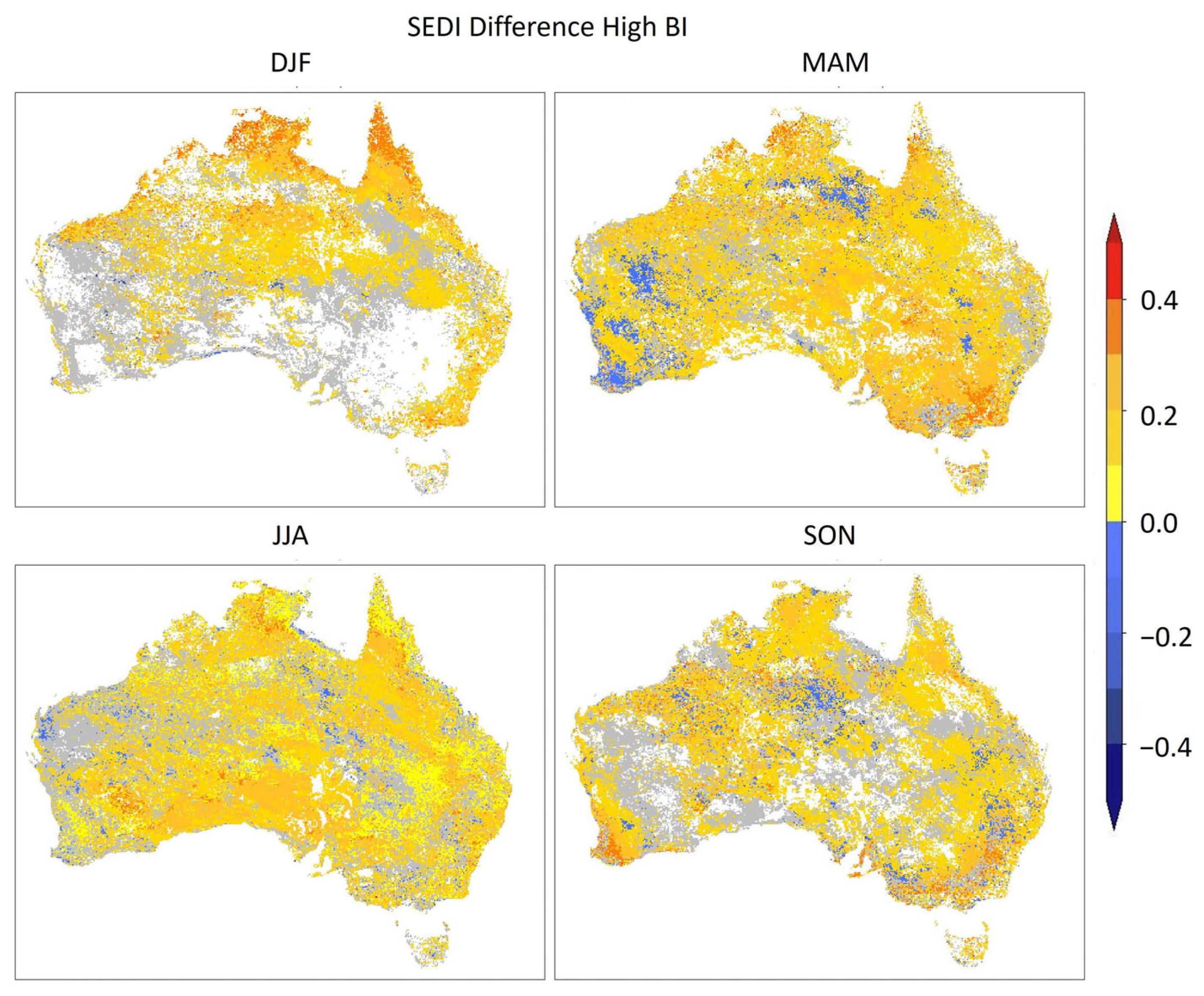
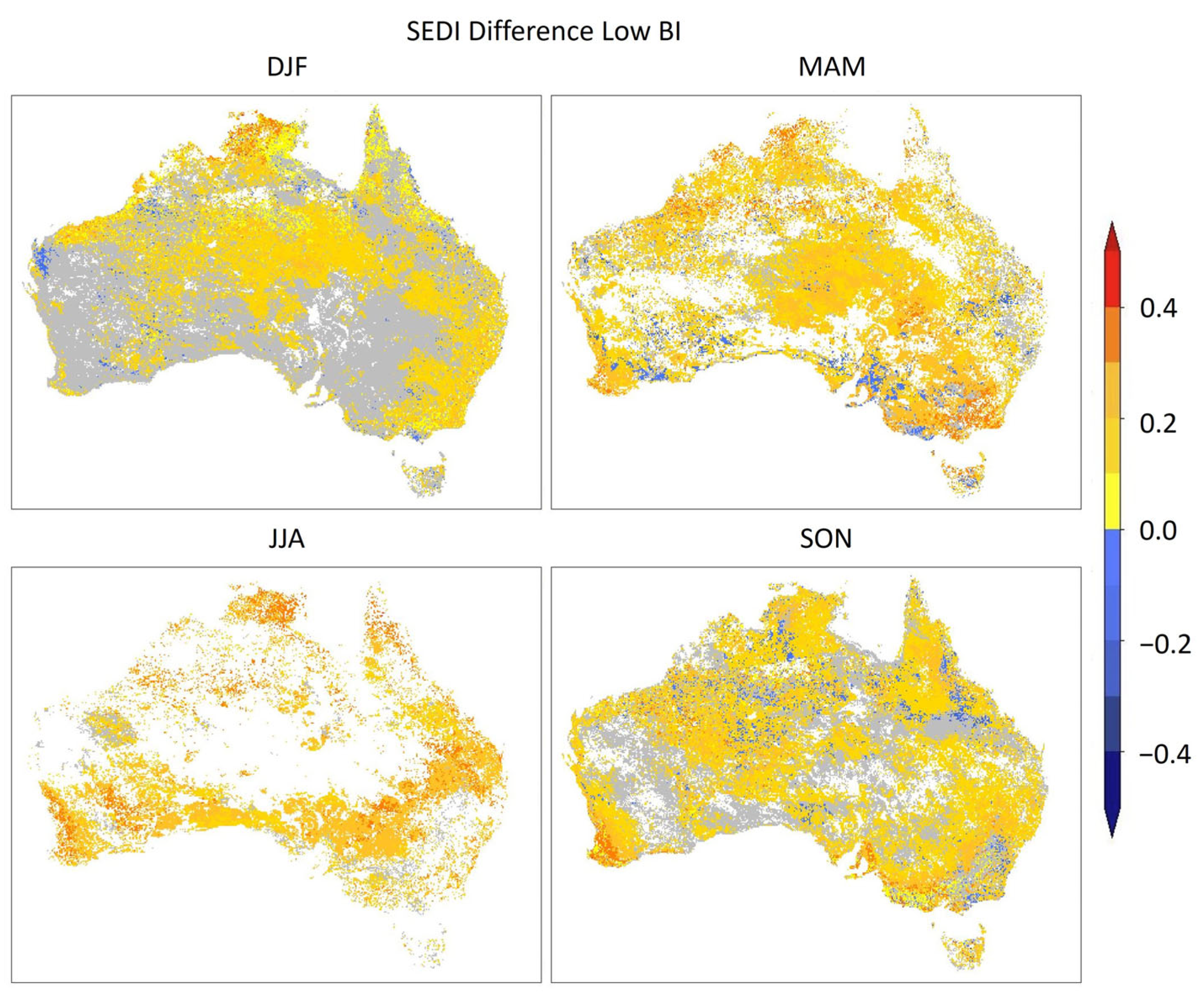

| Driver | Index | Reference Study |
|---|---|---|
| Madden-Julian Oscillation (MJO) | Real-time Multivariate MJO series 1 and 2 | Wheeler & Hendon, 2004 [34] |
| El Niño Southern Oscillation (ENSO) | NINO-3.4 | Trenberth, 1997 [35] |
| Indian Ocean Dipole (IOD) | Dipole Mode Index | Saji & Yamagata, 2003 [36] |
| Southern Annular Mode (SAM) | Antarctic Oscillation Index | Gong & Wang, 1999 [37] |
| Split-Flow Blocking | Blocking Index | Pook & Gibson, 1999 [38] |
| Subtropical Ridge Highs (STRH) | STRH Index | Marshall et al., 2014 [23] |
| DJF | Geographic quadrant | Predictive Skill Key | |||
| Driver | NE | SE | SW | NW | Excellent (SEDI difference > 0.50) |
| NINO3.4+ | |||||
| NINO3.4− | Good (SEDI difference 0.40–0.50) | ||||
| SAM+ | |||||
| SAM− | Fair/mixed (SEDI difference 0.30–0.40) | ||||
| STRH+ | |||||
| STRH− | Predominently low/insufficient data (SEDI difference > 0.30) | ||||
| BI+ | |||||
| BI− | |||||
| MJO phase 6 | |||||
| MAM | Geographic quadrant | Predictive Skill Key | |||
| Driver | NE | SE | SW | NW | Excellent (SEDI difference > 0.50) |
| NINO3.4+ | |||||
| NINO3.4− | Good (SEDI difference 0.40–0.50) | ||||
| SAM+ | |||||
| SAM− | Fair/mixed (SEDI difference 0.30–0.40) | ||||
| STRH+ | |||||
| STRH− | Predominently low/insufficient data (SEDI difference > 0.30) | ||||
| BI+ | |||||
| BI− | |||||
| MJO phase 6 | |||||
| JJA | Geographic quadrant | ||||
| Driver | NE | SE | SW | NW | |
| NINO3.4+ | Predictive Skill Key | ||||
| NINO3.4− | Excellent (SEDI difference > 0.50) | ||||
| SAM+ | |||||
| SAM− | Good (SEDI difference 0.40–0.50) | ||||
| IOD+ | |||||
| IOD− | Fair/mixed (SEDI difference 0.30–0.40) | ||||
| STRH+ | |||||
| STRH− | Predominently low/insufficient data (SEDI difference > 0.30) | ||||
| BI+ | |||||
| BI− | |||||
| MJO phase 2 | |||||
| SON | Geographic quadrant | ||||
| Driver | NE | SE | SW | NW | |
| NINO3.4+ | Predictive Skill Key | ||||
| NINO3.4− | Excellent (SEDI difference > 0.50) | ||||
| SAM+ | |||||
| SAM− | Good (SEDI difference 0.40–0.50) | ||||
| IOD+ | |||||
| IOD− | Fair/mixed (SEDI difference 0.30–0.40) | ||||
| STRH+ | |||||
| STRH− | Predominently low/insufficient data (SEDI difference > 0.30) | ||||
| BI+ | |||||
| BI− | |||||
| MJO phase 3 | |||||
Disclaimer/Publisher’s Note: The statements, opinions and data contained in all publications are solely those of the individual author(s) and contributor(s) and not of MDPI and/or the editor(s). MDPI and/or the editor(s) disclaim responsibility for any injury to people or property resulting from any ideas, methods, instructions or products referred to in the content. |
© 2024 by the authors. Licensee MDPI, Basel, Switzerland. This article is an open access article distributed under the terms and conditions of the Creative Commons Attribution (CC BY) license (https://creativecommons.org/licenses/by/4.0/).
Share and Cite
Taylor, R.; Marshall, A.G.; Crimp, S.; Cary, G.J.; Harris, S. Climate Driver Influences on Prediction of the Australian Fire Behaviour Index. Atmosphere 2024, 15, 203. https://doi.org/10.3390/atmos15020203
Taylor R, Marshall AG, Crimp S, Cary GJ, Harris S. Climate Driver Influences on Prediction of the Australian Fire Behaviour Index. Atmosphere. 2024; 15(2):203. https://doi.org/10.3390/atmos15020203
Chicago/Turabian StyleTaylor, Rachel, Andrew G. Marshall, Steven Crimp, Geoffrey J. Cary, and Sarah Harris. 2024. "Climate Driver Influences on Prediction of the Australian Fire Behaviour Index" Atmosphere 15, no. 2: 203. https://doi.org/10.3390/atmos15020203
APA StyleTaylor, R., Marshall, A. G., Crimp, S., Cary, G. J., & Harris, S. (2024). Climate Driver Influences on Prediction of the Australian Fire Behaviour Index. Atmosphere, 15(2), 203. https://doi.org/10.3390/atmos15020203








